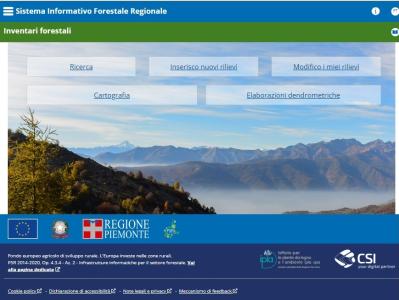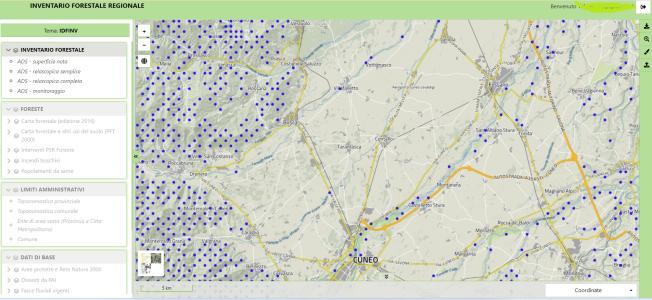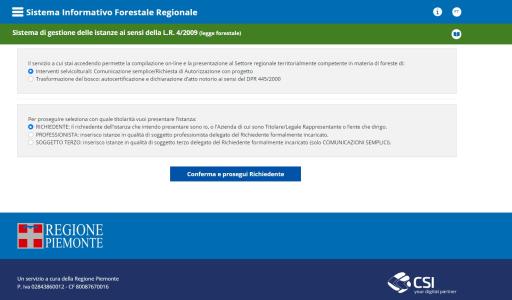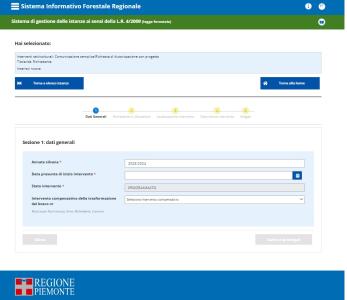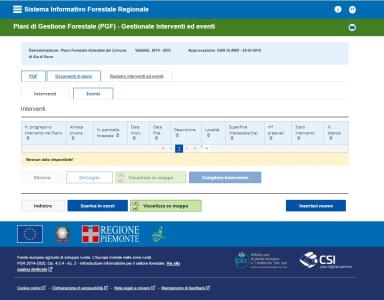Infrastruttura Dati Forestali
Forest data infrastructure
Description
The Forest Data Infrastructure (hereinafter referred to as IDF) is a whole
of databases and IT services that are interconnected and included in the
context of the Regional Forestry Information System (SIFOR), defined
Article 34 of Regional Law No 4/2009, which permits the sharing of information
updated on the Piedmont forest sector. IDF is addressed to operators
in the forestry sector: entrepreneurs, forestry workers
(including freelance technicians) and land managers
agroforestry operating throughout the region (Consorzi;
Forest associations managing public or private land,
as well as owners of large wooded areas (who have had plans)
Forestry holdings for their management). It includes the
the following components:
(1) forest management plans (former Farm Forestry Plans) which allow:
consultation of the approved Forest Management Plans (FGPs), and
management of the relevant register of interventions and events. The Plan for
Forest Management (FMP) is the tool for programming.
requests for communication and authorisations and management of interventions
natural selvicolts and related works. The Forestry Law (Regional Law No 4/2009)
recognises the role of FMPs within the planning system
regional forestry and assigns the initiative of drawing up FMPs to the
public or private forest owners. It lasts from 10 to 15 years,
with a programme of flexible forestry interventions on a three-year basis
or five years. Covers a minimum indicative size area
of at least 50 hectares of woodland with active management, also belonging to
different properties associated with or with a single operator;
2) forest inventories (productivity of Piedmont woods) enabling
management, alphanumeric and cartographic consultation and
dendrometric calculations of forest inventories. The role and
the importance of the Regional Forest Inventory is defined by law.
Piedmont Forest (Regional Law No 4/09). It is an essential component of the
Regional Forestry Plan (PF R) (Regional Law No 4/09, Art. 9) and in Piedmont
the studies for PFTs, which have been prepared on the whole surface area.
regional and which are the source of data collected using the methodology
homogeneous and coded, which allowed the inventory to be compiled. The
procedure allows agri-forestry land managers and companies
forests to develop the basic parameters autonomously (areas
basimetric, heights, volumes, increments) to define productivity
Piedmont woods with indications of their statistical value in
function of the territorial sample (s) taken in
consideration.
3) application management system within the meaning of Regional Law No 4/2009 (Law
forestry) allowing the presentation and consultation of
self-declarations and physical compensation projects relating to
operations to transform forests, simple communications and
applications for authorisation for forestry operations, and
applications for authorisation to recover chestnut trees and chestnut trees
fruit. In particular, the procedure concerns completion and sending to:
competent regional bodies of forestry bodies relating to the following
proceedings:
— Forest transformation: self-declaration and declaration of act
well-known under Presidential Decree No 445/2000
— Forestry measures: simple communications and authorisations with
project within the meaning of Article 14 of Regional Law No 4 of 10
February 2009 ‘Economic management and promotion of forests’;
presentation of physical compensation projects relating to interventions
conversion of woodland and applications for recovery authorisation
chestnut groves and fruit noccioles.
IDF provides valuable support for planning activities
Forestry, programming and verification of eligibility of
interventions under RDP forestry measures,
facilitating the dissemination of information related to the management of the
silvo-pastoral heritage, harmonising spatial data with the base
geographical reference data for the territory of Piedmont BDTRE and
integrating the functionalities offered by the different components of the system,
with a view to improving the management and usability of information
processed.
Features
- Consultation of the Forest Management Plans
- Management of the interventions and events of the Forest Management Plans
- Management of Forestry Inventories
- Management of forest applications

